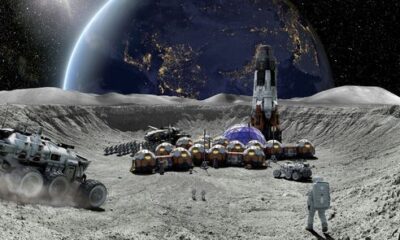Science
Expert Warns of Risks as Humanoid Robots Edge Towards Use

The development of autonomous humanoid robots is advancing, yet a leading UK robotics expert cautions that significant challenges still lie ahead. Dr. Carl Strathearn, a Lecturer in Computer Science at Edinburgh Napier University and adviser on AI and robotics to the UK Government’s Office for Science, will address these issues at New Scientist Live, taking place from October 18 to 20, 2023, at London ExCel.
Despite impressive demonstrations of robots performing tasks like pouring drinks and folding clothes, Dr. Strathearn argues that we are still years away from having truly functional humanoids. He emphasizes that current technology often relies on virtual simulations and lacks the real-world data necessary for effective training. “The biggest problem is the lack of real-world data and the technological means of gathering it in large enough quantities to train our robots effectively,” he stated.
The disparity between lab performance and real-world application presents a significant hurdle. He illustrates this by comparing a simple object, such as a cup, which comes in countless variations of size, shape, and color. “Now extrapolate that to every object in a house, and you can see the scale of the challenge,” Dr. Strathearn added.
One potential avenue for addressing this data gap is crowdsourcing. Dr. Strathearn suggested using devices like Meta’s Ray-Ban smart glasses to collect extensive data. However, he acknowledges the ethical complexities and logistical challenges of involving thousands, if not millions, of people in such an initiative.
While concerns about robots turning against humanity often dominate popular discourse, Dr. Strathearn insists that the real risk lies in human mismanagement of these technologies. He is advocating for stringent regulations on humanoid robots in public spaces after observing a series of near misses involving humans and robots. “Humans control them using handheld devices, which makes them very dangerous and unreliable,” he explained. “There are more and more instances of serious near misses between humans and robots—not because of AI, but because of humans.”
The perception of robots also presents challenges. Dr. Strathearn notes that robots designed to look too human-like may provoke discomfort, a phenomenon known as the “uncanny valley.” Yet, in specific contexts such as dementia care, a familiar human-like appearance could provide comfort. He pointed out, “People have different thresholds of perception when it comes to creepiness. That’s why we have different types of robots—some very lifelike, some with just minimal facial features.”
Dr. Strathearn’s research even includes the “Multimodal Turing Test,” which investigates how communication through lifelike robots can enhance the perception of AI as human. Japanese researchers later validated this concept, finding that people are more likely to believe AI is human when it interacts through a realistic robot.
Despite these insights, the race among companies to develop humanoid robots continues, often fueled by hype. “The hype is a major issue. We are far from humanoid robots that are good enough to do everyday tasks effectively, but that doesn’t stop major companies wanting to mass produce them,” Dr. Strathearn remarked. He noted an acute skills shortage in the field of robotics, pointing out that universities often compartmentalize education into separate disciplines, whereas the future of robotics will require interdisciplinary training.
Looking towards potential applications, Dr. Strathearn proposes that humanoid robots may find immediate use in space exploration, rather than in everyday domestic tasks. “Space exploration for sure—we could use telemetric or AI-controlled humanoids to work in space for longer periods than humans, advancing us further into the unknown,” he said. He believes these robots could even assist in terraforming planets or exploring areas that current robotic rovers cannot reach.
As Dr. Strathearn concludes, while the potential for robots to assist in colonizing other worlds exists, the pressing challenge here on Earth is to ensure that humanoid robots are safe, reliable, and properly regulated before they are integrated into society. “Robots might terraform Mars one day. But on Earth, only strict regulation will keep us safe,” he emphasized.
The conversation surrounding humanoid robots is set to evolve, and the upcoming New Scientist Live event will provide a platform for these crucial discussions.
-

 Entertainment3 months ago
Entertainment3 months agoAnn Ming Reflects on ITV’s ‘I Fought the Law’ Drama
-

 Entertainment4 months ago
Entertainment4 months agoKate Garraway Sells £2 Million Home Amid Financial Struggles
-

 Health3 months ago
Health3 months agoKatie Price Faces New Health Concerns After Cancer Symptoms Resurface
-

 Entertainment3 months ago
Entertainment3 months agoCoronation Street’s Carl Webster Faces Trouble with New Affairs
-

 Entertainment3 months ago
Entertainment3 months agoWhere is Tinder Swindler Simon Leviev? Latest Updates Revealed
-

 Entertainment4 months ago
Entertainment4 months agoMarkiplier Addresses AI Controversy During Livestream Response
-

 Science1 month ago
Science1 month agoBrian Cox Addresses Claims of Alien Probe in 3I/ATLAS Discovery
-

 Entertainment4 months ago
Entertainment4 months agoKim Cattrall Posts Cryptic Message After HBO’s Sequel Cancellation
-

 Entertainment3 months ago
Entertainment3 months agoOlivia Attwood Opens Up About Fallout with Former Best Friend
-

 Entertainment6 days ago
Entertainment6 days agoCoronation Street Fans React as Todd Faces Heartbreaking Choice
-

 Entertainment3 months ago
Entertainment3 months agoMasterChef Faces Turmoil as Tom Kerridge Withdraws from Hosting Role
-

 Entertainment4 months ago
Entertainment4 months agoSpeculation Surrounds Home and Away as Cast Departures Mount



















